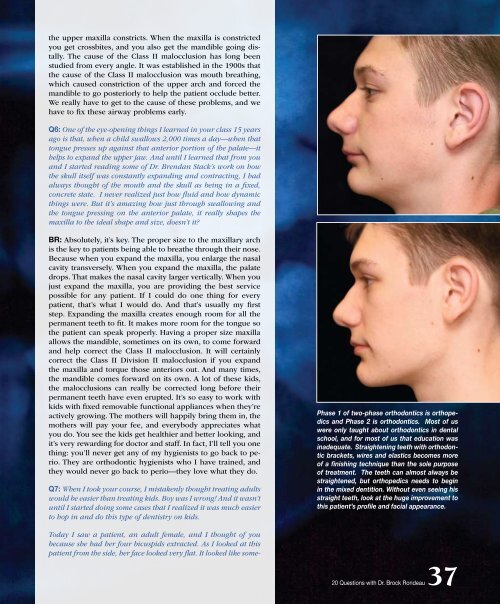Chairside - Glidewell Dental Labs
Chairside - Glidewell Dental Labs
Chairside - Glidewell Dental Labs
You also want an ePaper? Increase the reach of your titles
YUMPU automatically turns print PDFs into web optimized ePapers that Google loves.
the upper maxilla constricts. When the maxilla is constricted<br />
you get crossbites, and you also get the mandible going distally.<br />
The cause of the Class II malocclusion has long been<br />
studied from every angle. It was established in the 1900s that<br />
the cause of the Class II malocclusion was mouth breathing,<br />
which caused constriction of the upper arch and forced the<br />
mandible to go posteriorly to help the patient occlude better.<br />
We really have to get to the cause of these problems, and we<br />
have to fix these airway problems early.<br />
Q6: One of the eye-opening things I learned in your class 15 years<br />
ago is that, when a child swallows 2,000 times a day—when that<br />
tongue presses up against that anterior portion of the palate—it<br />
helps to expand the upper jaw. And until I learned that from you<br />
and I started reading some of Dr. Brendan Stack’s work on how<br />
the skull itself was constantly expanding and contracting, I had<br />
always thought of the mouth and the skull as being in a fixed,<br />
concrete state. I never realized just how fluid and how dynamic<br />
things were. But it’s amazing how just through swallowing and<br />
the tongue pressing on the anterior palate, it really shapes the<br />
maxilla to the ideal shape and size, doesn’t it?<br />
BR: Absolutely, it’s key. The proper size to the maxillary arch<br />
is the key to patients being able to breathe through their nose.<br />
Because when you expand the maxilla, you enlarge the nasal<br />
cavity transversely. When you expand the maxilla, the palate<br />
drops. That makes the nasal cavity larger vertically. When you<br />
just expand the maxilla, you are providing the best service<br />
possible for any patient. If I could do one thing for every<br />
patient, that’s what I would do. And that’s usually my first<br />
step. Expanding the maxilla creates enough room for all the<br />
permanent teeth to fit. It makes more room for the tongue so<br />
the patient can speak properly. Having a proper size maxilla<br />
allows the mandible, sometimes on its own, to come forward<br />
and help correct the Class II malocclusion. It will certainly<br />
correct the Class II Division II malocclusion if you expand<br />
the maxilla and torque those anteriors out. And many times,<br />
the mandible comes forward on its own. A lot of these kids,<br />
the malocclusions can really be corrected long before their<br />
permanent teeth have even erupted. It’s so easy to work with<br />
kids with fixed removable functional appliances when they’re<br />
actively growing. The mothers will happily bring them in, the<br />
mothers will pay your fee, and everybody appreciates what<br />
you do. You see the kids get healthier and better looking, and<br />
it’s very rewarding for doctor and staff. In fact, I’ll tell you one<br />
thing: you’ll never get any of my hygienists to go back to perio.<br />
They are orthodontic hygienists who I have trained, and<br />
they would never go back to perio—they love what they do.<br />
Q7: When I took your course, I mistakenly thought treating adults<br />
would be easier than treating kids. Boy was I wrong! And it wasn’t<br />
until I started doing some cases that I realized it was much easier<br />
to hop in and do this type of dentistry on kids.<br />
Today I saw a patient, an adult female, and I thought of you<br />
because she had her four bicuspids extracted. As I looked at this<br />
patient from the side, her face looked very flat. It looked like some-<br />
Phase 1 of two-phase orthodontics is orthopedics<br />
and Phase 2 is orthodontics. Most of us<br />
were only taught about orthodontics in dental<br />
school, and for most of us that education was<br />
inadequate. Straightening teeth with orthodontic<br />
brackets, wires and elastics becomes more<br />
of a finishing technique than the sole purpose<br />
of treatment. The teeth can almost always be<br />
straightened, but orthopedics needs to begin<br />
in the mixed dentition. Without even seeing his<br />
straight teeth, look at the huge improvement to<br />
this patient’s profile and facial appearance.<br />
20 Questions with Dr. Brock Rondeau37

















